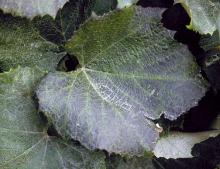Cause Unknown. A leaf discoloration known as blackleaf, brownleaf, chocolate leaf, or blattbraune is a problem in eastern Washington. Blackleaf is associated with potassium deficiency, severe overcropping, poor soils, sun exposure, drought, and/or high summer temperatures. Whether these factors are directly responsible for blackleaf or merely correlative with symptom expression is unknown. Blackleaf is particularly noticeable in Vitis labrusca cultivars such as Concord. It has a negative impact on fruit ripening and quality.
Development of blackleaf and classic potassium deficiency appear to be independent. Applying potassium fertilizer has increased leaf tissue potassium content but only partially alleviated blackleaf symptoms.
Research on 'Concord' grapevines indicates excessive sunlight initiates blackleaf symptoms. Prolonged exposure to certain light levels causes dysfunction of photosynthesis and symptom development. Reducing either total sunlight or the ultraviolet component transmitted to the canopy decreased symptom development. Water deficit stress at any time during the growing season increased blackleaf development.
Symptoms Symptoms usually appear near veraison. A discoloration of the mesophyll tissue (browning) is followed by a reddish-brown, blue-violet, or black discoloration of dots, flecks, or streaks within the upper epidermis. The discolored areas expand to cover over 50% of the leaf surface. Only the parts of leaves of the outer canopy that are fully exposed to sunlight develop symptoms. In severe cases, the entire sun-exposed leaf area becomes black and chlorotic, resulting in premature defoliation.
Classic potassium deficiency symptoms usually occur shortly after fruit-set in leaves at the midshoot position and are characterized by chlorosis originating at leaf margins and progressing to interveinal regions of the leaf. Unlike potassium deficiency injury, blackleaf has no particular pattern of origination within the leaf.
Cultural control
- Fertilize according to soil or tissue test results. Do not add excess potassium.
- Maintain adequate moisture above the permanent wilting point but below field capacity. Minimize drought stress especially early in the growing season for 'Concord'.
Chemical control The use of sun-blocking compounds is recommended for areas with a perennial problem.
- Surround WP at 25 lb/50 gallons water/A. A dry white film will result on all treated plant parts and may be a problem for wine grapes after veraison. 4-hr reentry. O
Reference Smithyman, R.P., Wample, R.L., and Lang, N.S. 2001. Water deficit and crop level influences on photosynthetic strain and blackleaf symptom development in Concord grapevines. American journal of enology and viticulture, 52:364-375.

